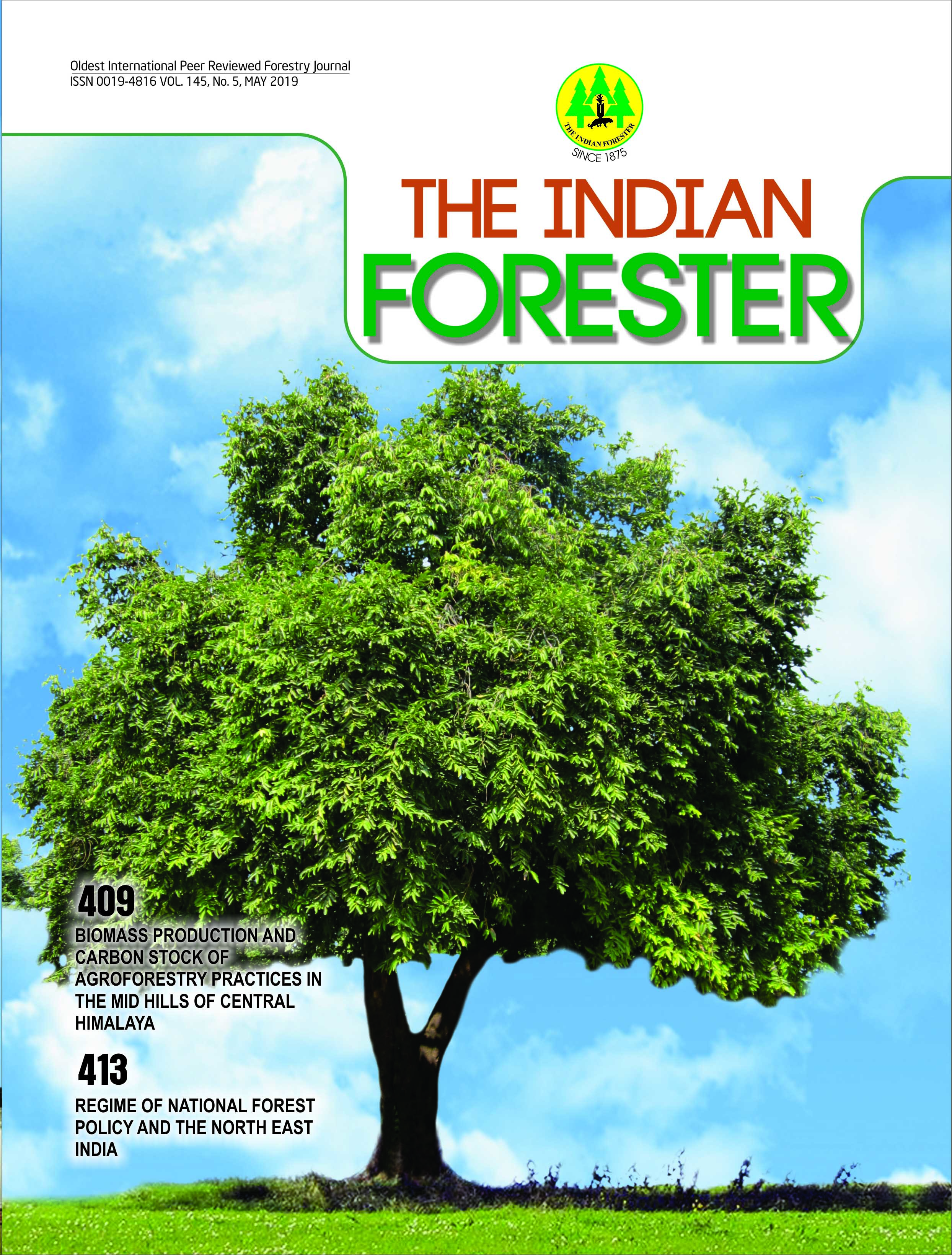Regeneration Potential of Different Species of Conifers in Natural Forests of Kashmir Himalaya
DOI:
https://doi.org/10.36808/if/2019/v145i5/145685Keywords:
Regeneration potential, Seedlings, Saplings, Abies pindrow, Kashmir Himalaya.Abstract
Regeneration potential refers to processes including production, dispersal and germination of tree seeds and the subsequent establishment of seedlings. Regeneration of forests is a major concern for forest managers now a day on account of large-scale deforestation. For the purpose, a thorough survey of the affected forests is a prerequisite. In the present study, an attempt was made to get an insight about the present status and future prospects of dominant tree species of forests of Langate Forest Division in Kashmir Himalaya. The tree community of the studied forests is dominated by conifers. A total of five species represented the coniferous community of Langate forests. Among the species Abies pindrow, Picea smithiana and Cupressus sp. showed contagious distribution (A/F > 0.05) while as Cedrus deodara and Pinus wallichiana depicted randomly to regular distribution patterns. The study revealed different facets of regeneration potential for different species. Cedrus deodara and Pinus wallichiana were found to have fair prospects of regeneration with a density of mature trees, saplings and seedlings varying in the order: seedlings > saplings > mature trees at all the four selected sites. The populations of third dominant species Abies pindrow were found dwindling as is evident from a low density of seedlings and saplings at all the sites and hence needs immediate attention.References
Barik S.K., Rao P., Tripathi R.S. and Pandey H.N. (1996). Dynamics of tree seedling populations in a humid subtropical forest of north-east India as related to the disturbance. Can. J. For. Res., 26: 584-589.
Bullock J. (2000). Gaps and seedling colonization. In: Fenner, M.(ed.), Seeds: The Ecology of Regeneration in Plant Communities. CABI Publishing, U.K. 375-395 pp.
Chapin F.S., Zaveleta E.S., Eviner V.T., Naylor R.L., Vitousek P.M. and Lavorel S. (2000). Consequences of changing biotic diversity. Nature, 405: 234-242.
Curtis J.T. and Cottam G. (1956). Plant Ecology Workbook. Laboratory Field Reference Manual. Burgess Publ. Co., Minnesota. 193pp.
Curtis J.T. and McIntosh R.P. (1950). The interrelations of certain analytic and synthetic phytosociological characters. Ecology, 31: 434-455.
Grime J.P. (1979). Plant strategies and vegetation processes. John Wiley and Sons, New York.
Huange W., Pohjonen V., Johansson S., Nashanda M., Katigula M.I.L. and Luukkanen O. (2003). Species Diversity, Forest Structure and Species Composition in Tanzanian Tropical Forests. Forest Ecology and Management, 173: 11-24.
Khan M.L., Rai J.P.N. and Tripathi R.S. (1987). Population structure of some tree species in disturbed and protected sub-tropical forests of north-east India. Acta Oecologia: Oecologia Applicata (France), 8:247-255.
Li Q.Z., Bogaert J. and Nijs I. (2005). Gap pattern and colonization opportunities in plant communities: effects of species richness, mortality and spatial aggregation. Ecography, 28: 770-790
Misra R. (1968). Ecology Workbook. Oxford and IBH Publishing Company, Calcutta.
Mueller-Dombois D. and Ellenberg H. (1974). Aims and Methods of Vegetation Ecology. John-Wiley, New York.
Penuelas J., Ogaya R., Boada M. and Jump A.S. (2007). Migration, invasion, and decline: changes in recruitment and forest structure in a warming-linked shift of European beech forest in Catalonia (NE Spain). Ecography, 30:829-837.
Peterson D.W., Peterson D.L., Ettl G.J. Morrison S.F., Forbes G.J., Young S.J., O'Neill K.P., Kasischke E.S., Richter D.D. and Cruickchank M.G. (2002). Growth responses of subalpine fir to climatic variability in the Pacific Northwest. Can. J. For. Res., 32: 1503-1517.
Ralhan P.K., Saxena A.K. and Singh J.S. (1982). Analysis of forest vegetation at and around Nainital in Kumaun Himalaya. Proc. Indian Natn. Sci. Acad., 48:122-128.
Sapkota I.P., Tigabu M. and Oden P.C. (2009). Species diversity and regeneration of old-growth seasonally dry Shorea robusta forests following gap formation. J. For. Res., 20: 7-14.
Shugart Jr. H.C. and West D.C. (1980). Forest succession models. Bioscience, 30: 308-313.
Spurr S.H. and Barnes B.V. (1980). Forest Ecology. John Wiley, New York, 687 pp.
Stone P.B. (1992). State of the World's Mountains –A Global Report. Mountain Agenda. 391 p.
Taylor A.H., Shi Wei J., Lian Jun Z., Chun Ping L., Chang Jin, M. and Jinyan H. (2006). Regeneration patterns and tree species coexistence in old-growth Abies-Piceae,/i> forests in southwestern China. For. Ecol. Manage., 223: 303-317.
Van Der Meer P.J. and Bongers F. (1996). Formation and closure of canopy gaps in the rain forest at Nouragues, French Guiana. Vegetatio, 126: 167-179
Wang T., Liang Y., Ren H., Yu D., Ni J. and Ma K. (2004). Age structure of Picea schrenkiana forest along an altitudinal gradient in the central Tianshan Mountains, northwestern China. For. Ecol. Manage., 196: 267-274.
Wang W., Franklin S.B., Ren Y. and Quellette J.R., (2006). Growth of bamboo Fargesia qinlingensis and regeneration of trees in a mixed hardwood-conifer forest in the Qinling Mountains, China. For. Ecol. Manage., 234: 107-115.
Whitford P.B. (1949). Distribution of woodland plants in relation to succession and clonal growth. Ecology, 30: 199-208.
Whitmore T.C. (1998). An Introduction to Tropical Rain Forests. Oxford University Press, New York.
Yadava P.S., Singh E.J., Soreishang K.A.S. (1991). Tree population structure of sub-tropical forests of Manipur, northeastern India and its implications for their regeneration. pp. 1323. In: Advances in Himalayan Ecology (Rajwar, G.S. (eds.). Today and Tomorrow's Printers and Publishers, New Delhi.
Yodzis P. (1976). Species richness and stability of spacelimited communities. Nature, 264: 540-541.
Downloads
Downloads
Published
How to Cite
Issue
Section
License
Unless otherwise stated, copyright or similar rights in all materials presented on the site, including graphical images, are owned by Indian Forester.





